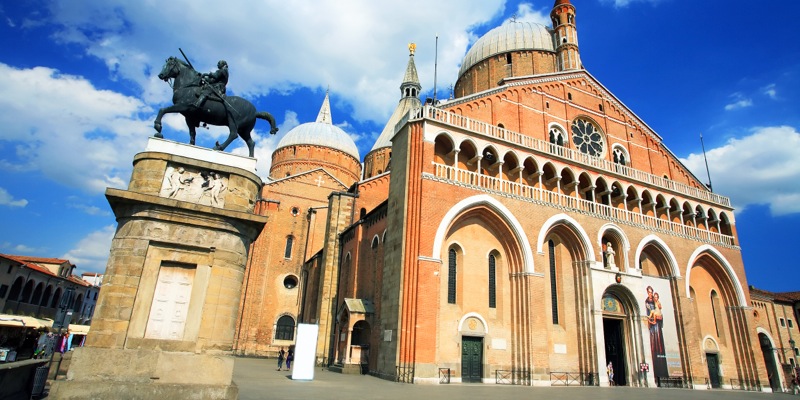The Basilica of Saint Anthony, known as "The Saint", is the most important religious center of the city and attracts thousands of pilgrims every year especially on 13th June, the feast of the Saint.
The Basilica was built in 1232 to guard the tomb of the Franciscan friar Antonio who died in Padua in 1231.
The large building presents a complex structure with a fusion of styles: Romanesque elements in the facade, Gothic elements in the map of the ambulatory, Byzantine elements in the eight domes covered in lead and Moorish elements in two thintower bells.
There are numerous reminders of the Carraresi signoria in the Church of St. Anthony. In 1350, Cardinal Guido de Boulogne came to the cathedral for the recognition of the miracle of the Saint's body, and was welcomed by Jacopo II da Carrara and Bishop Hildebrand.
Members of the Carraresi family circle, such as the Lupi di Soragna and the Conti, selected the Basilica as the site for their own mausoleums. The location of the prior church at the site, St. Mary Mother of the Lord, is now occupied by the Chapel of the Black Madonna. The polychrome Mary is by Rinaldino di Francia, and dates to 1396 - Rinaldino is probably also the author of the shield with portrait of Stefano da Carrara, now in the Civic Museums. A funeral monument to Raffaele Fulgioso, a celebrated jurist of the University of Padua, is to the left of the chapel. The Chapel of the Blessed Luca offers still closer contacts with the Carraresi family: the chapel was constructed between 1380 and 1382 by Naimerio and Manfredino Conti, as executors of the Fina Buzzaccarini's will. They called on Giusto de'Menabuoi, painter to the Carraresi court, for the frescos. The stories of saints Phillip and James, laid out on the chapel walls, show a surprising new sense of spaciousness. At the centre, in the lunette, are the portraits of the sponsors as they are presented to the Virgin by Sant'Antonio, the Blessed Luca, St. Francis and St. Ludovico of Toulouse. On the right of the apse is the praying Beato Luca; on the left is St. Anthony shows the city, liberated from the tyranny of Ezzelino, to the Blessed Luca.
In the Crucifixion of St. Phillip, Giusto inserts a portrait of Francesco the Elder in the guise of a centurion, and of Ezzelino and Guido, the children of Beroaldo Conti. In the first right-hand chapel of the choir surround, now known as Chapel of the Benediction, but in the 1300s under the patronage of the Scrovegni family, there are frescos of the Saints. There is also a Crucifixion on the wall at the entrance to this chapel, identified as one of the first works at Padua by Giotto. Giotto also worked on an important commission from the Franciscans: the frescos of the Sala del Capitolo (Chapter Hall), of which we can still admire St. Francis Receives the Stigmata and a Prophet, fragments of a Crucifixion, and saints of the order. In the passage between the basilica and the Franciscan cloister there are the tombs of the podesta Nicolo da Lavellongo and of two intimates of the Carraresi and Petrarch: Bonzanello and Nicolo da Vigonza, surmounted by the admirable Coronation of the Virgin by Giusto de'Menabuoi. The cloister contains the burial monument for Rolando da Piazzola. The house in front of the Basilica (number 19 on the Piazza) was a gift from Francesco Novello to the Padua University of Jurists, to compensate them for the prebendary income they lost as a result of splitting off the University of the Artists. Donatello lived in this house during his stay in Padua.
Are you a local? What do you think about Basilica of Sant'Antonio?
Login to suggest it!


